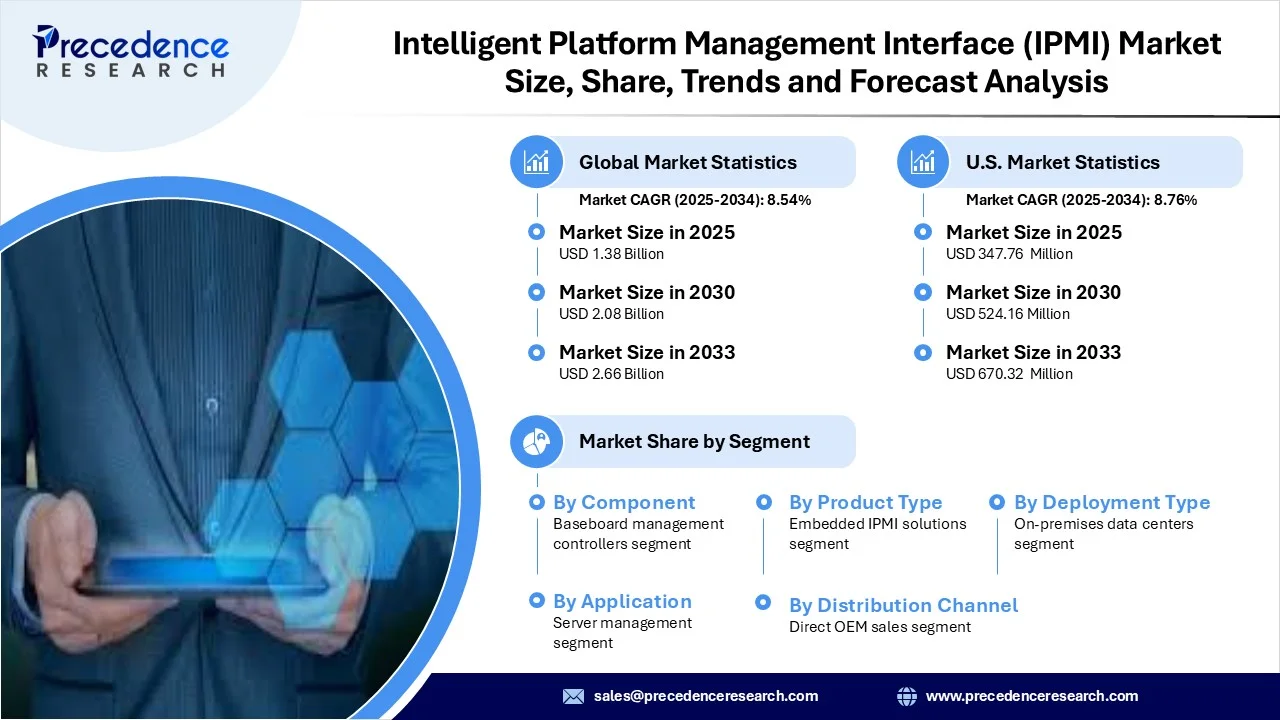Intelligent Platform Management Interface (IPMI) Market Revenue to Attain USD 2.66 Bn by 2033
Intelligent Platform Management Interface (IPMI) Market Revenue and Trends 2025 to 2033
The global intelligent platform management interface (IPMI) market revenue reached USD 1.38 billion in 2025 and is predicted to attain around USD 2.66 billion by 2033 with a CAGR of 8.54%. This market is on the rise primarily due to escalating demand for remote monitoring, server management, and enhanced data center reliability.

Key drivers influencing the growth of the Intelligent Platform Management Interface (IPMI) Market:
Accelerating digital transformation across sectors requires large infrastructures, increasing the number of servers, hyperscale data centers, and cloud or hybrid deployments, which must now be monitored and managed continuously. Operational uptime and system resiliency with a focus on business-critical operations have become mission essential for organizations in the BFSI, telecom, healthcare, and public sectors. Therefore, devices and tools like intelligent platform management interface that work when the operating system goes down or fails provide a reliable means to track system health and status.
Segment Insights:
- By component, Baseboard Management Controllers (BMCs) represent the largest share of revenue, due to their ability to provide out-of-band hardware monitoring and control that can be examined at manager or even the manufacturing level.
- By product type, embedded IPMI solutions within servers and storage systems dominate, as there is no need to include an external module and deployment is straightforward and often automatic.
- By functionality/features, hardware health monitoring & out-of-band management are the most widely used features, as they provide continuous visibility of a device even if both the OS and/or other software have failed.
- By deployment type, on-premises enterprise & colocation data centers are the most common deployment type, as considerable investments are made into physical infrastructure that need to be continually managed and maintained reliably.
- By application, server management is the dominating and the most widely used segment, because of the need for uptime, remote resets, diagnostics in core compute environments.
- By protocol/interface support, IPMI 2.0 is the dominant protocol used, as it has been developed over years and continues to evolve, but the level of support, and is the standard baseline for many hardware vendors.
- By data transmission mode, LAN-based IPMI is the dominant, as most remote management purposes functionality use an IP-over-LAN means of reachability and often does not utilize the OS in this process.
- By integration level, rack servers with embedded IPMI controllers represent dominant integration level in terms of products in this market, as its clear many racks in modern data centers have management integration into these racks and each server.
- By distribution channel, the OEM direct integration lead is important because many server, storage, and hardware vendors embed IPMI and BMCs pre-made and in-prepared, instead of aftermarket.
Intelligent Platform Management Interface (IPMI) Market Coverage
| Report Attribute | Key Statistics |
| Market Revenue in 2025 | USD 1.38 Billion |
| Market Revenue by 2033 | USD 2.66 Billion |
| CAGR from 2025 to 2033 | 8.54% |
| Quantitative Units | Revenue in USD million/billion, Volume in units |
| Largest Market | North America |
| Base Year | 2024 |
| Regions Covered | North America, Europe, Asia-Pacific, Latin America, and Middle East & Africa |
Regional Insights
North America has the largest share of the global IPMI market, primarily due to the existing tech infrastructure, large number of hyperscale data centers, widespread cloud adoption, volume of suppliers (Intel, Dell, Cisco), and associated regulatory compliance in the areas of uptime, performance, and security.
Asia-Pacific is the most significant region moving forward in terms of growth. Countries such as China, India, Japan, and South Korea are investing extensively in data center build-out, 5G and telecom infrastructure, cloud and edge computing, and smart city and IoT deployments. All of which are pushing increased deployment of IPMI systems, embedded BMCs, and secure remote management solutions to fulfill compliance obligations.
Intelligent Platform Management Interface (IPMI) Market Key Players
- ASPEED Technology Inc.
- American Megatrends International (AMI)
- Arm Ltd.
- Cisco Systems, Inc.
- Dell Technologies
- Fujitsu Ltd.
- Hewlett Packard Enterprise (HPE)
- Intel Corporation
- Lenovo Group Ltd.
- Microchip Technology Inc.
- NEC Corporation
- NVIDIA Corporation (Mellanox IPMI solutions)
- Supermicro Computer Inc.
- Synopsys Inc. (IP cores for IPMI integration)
- Tyan Computer Corporation
Recent Developments
- On March 11, 2025, Supermicro introduced a new line of compact servers optimized for “edge and embedded workloads,” based on the latest Intel Xeon 6 (Granite Rapids-D) processors. These systems deliver higher memory bandwidth, more CPU cores, and are suitable for real-time AI inferencing, telecom, networking, CDN, etc. (Source: https://ir.supermicro.com)
Get this report to explore global market size, share, CAGR, and trends, featuring detailed segmental analysis and an insightful competitive landscape overview @ https://www.precedenceresearch.com/sample/6777
You can place an order or ask any questions, please feel free to contact at sales@precedenceresearch.com |+1 804 441 9344